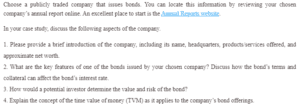Analyzing Corporate Bonds
The company that is the focus of this paper is Apple Incorporation. The firm is an American multinational technology corporation and is stationed in Cupertino, California. The business engages in the design, development, sale, and repair of consumer electronics, ranging from computers, phones, tablets, and software products. Its services include advertising, fee-based repair services, digital content, cloud services, and payment services. It also provides wearable, home, and accessory products such as HomePods, iPods, AirPods, Apple TV, Apple Watch, and Beats. It is approximated that the firm’s total net worth is $1.3 trillion based on its market capitalization, which makes it the most valuable company on earth (Apple, 2019).
Key features of the company’s bonds
According to Market Insider (2020), Apple issued its current bond in 2017. The bond volume was 1,000,000,000 with the USD currency. Its issue price was $99.77, while its issue date was 6/20/2017. Its coupon rate was 3.0% with a denomination of 1000, and it was to be paid with a regular interest rate. Its maturity rate is 6/20/2027, while its coupon payment date is 12/20/2020. It would be paid twice a year and does not have a floater. The inclusion of collateral can affect a bond’s interest rates by lowering them. On the other hand, the higher the bond term in the form of duration, the more susceptible to interest rate sensitivity.
How an investor can determine the value and risk of bonds
The determination of the value of bonds can be performed by ascertaining their cash flow and the bond’s value when it matures. An investor can determine the value of a bond by adding the present value of the interest payments to the present value of the maturity that one receives at maturity. The purpose of adding the present value is that it quantifies the value of future payments into today’s currency denomination. Similarly, the risk of a bond can be calculated by determining the return rate for a risk-free investment, such as a government bond from the US Treasury Department, which is inflation-protected. Secondly, one should subtract the rate of return of the treasury bond from the corporate bond. Thirdly, one should subtract the result from the expected rate of inflation. Fourthly, one should then subtract any other premiums specific to this bond and then arrive at the expected rate of default (Motley, 2016).
How time value of money applies to the company’s bond offering
The time value of money is a concept that anticipates the degree to which a sum of money available today will be worth more than the identical sum in the future due to the potential growth of some factors, such as inflation and interest rates. According to Silver (2011), the concept is based on the fact that the amount of money held today, such as $100, will be worth more than a similar denomination in the future. The assertion means that with $100, one can buy more units of an item today than they would in the future. The concept applies to a company’s bond offering as it is factored in the returns that an investor is to receive upon the bond’s maturity. The calculation of the sum’s value in the future is calculated by multiplying the present value of the money by a predetermined interest rate, the number of years, and compounding periods.
References
Apple (2019). Annual Report: Apple Incorporation. Retrieved 11th December 2020 from https://s2.q4cdn.com/470004039/files/doc_financials/2020/ar/_10-K-2020-(As-Filed).pdf
Market Insider. (2020).APPLE INC.DL-NOTES 2017(17/27). Retrieved 11th December 2020 from https://markets.businessinsider.com/bonds/apple_incdl-notes_201717-27-bond-2027-us037833cx61
Motley. (2016). How to Find a Default Risk Premium on a Corporate Bond. Retrieved 11th December 2020 from https://www.fool.com/knowledge-center/how-to-find-a-default-risk-premium-on-a-corporate.aspx
Silver, T. L. (2011). The Time Value of Life: Why Time Is More Valuable Than Money. iUniverse.
ORDER A PLAGIARISM-FREE PAPER HERE
We’ll write everything from scratch
Question
Choose a publicly traded company that issues bonds. You can locate this information by reviewing your chosen company’s annual report online. An excellent place to start is the Annual Reports website.

Analyzing Corporate Bonds
In your case study, discuss the following aspects of the company.
- Please provide a brief introduction of the company, including its name, headquarters, products/services offered, and approximate net worth.
- What are the key features of one of the bonds issued by your chosen company? Discuss how the bond’s terms and collateral can affect the bond’s interest rate.
- How would a potential investor determine the value and risk of the bond?
- Explain the concept of the time value of money (TVM) as it applies to the company’s bond offerings.

